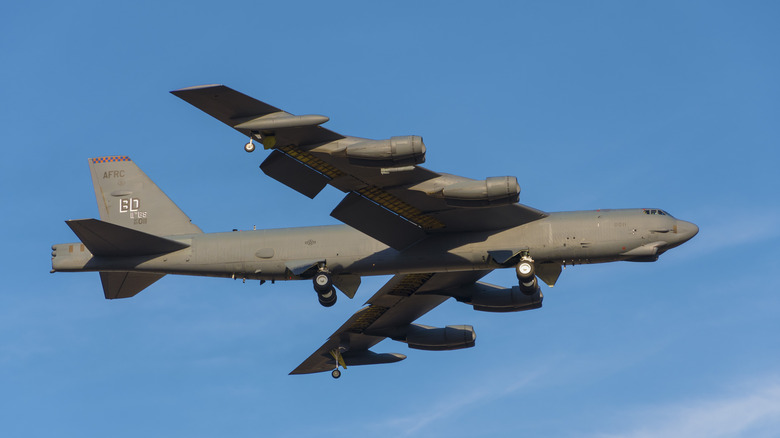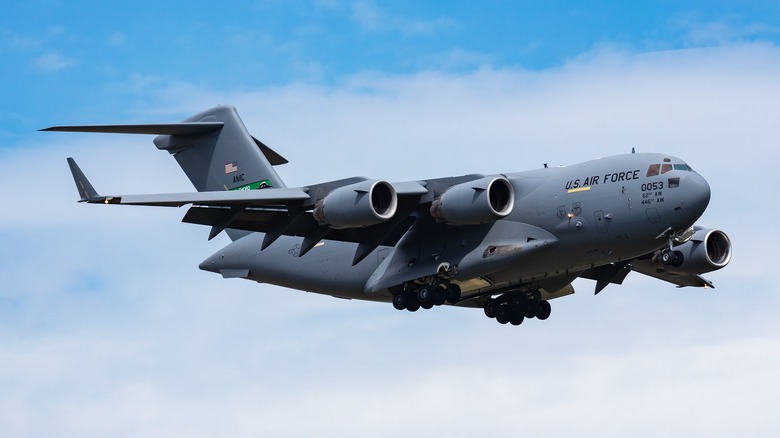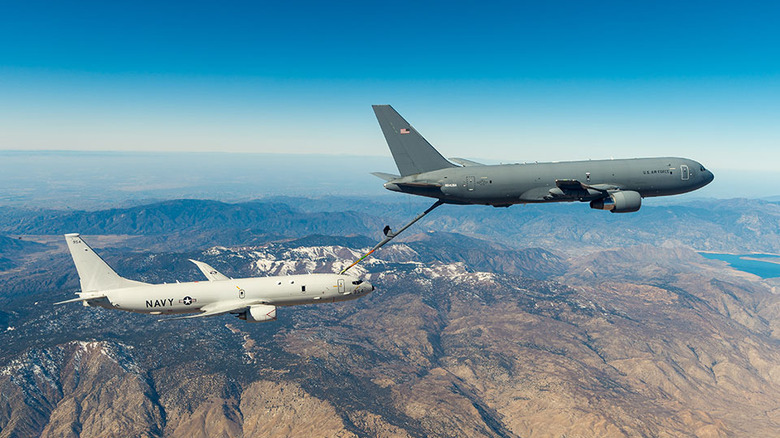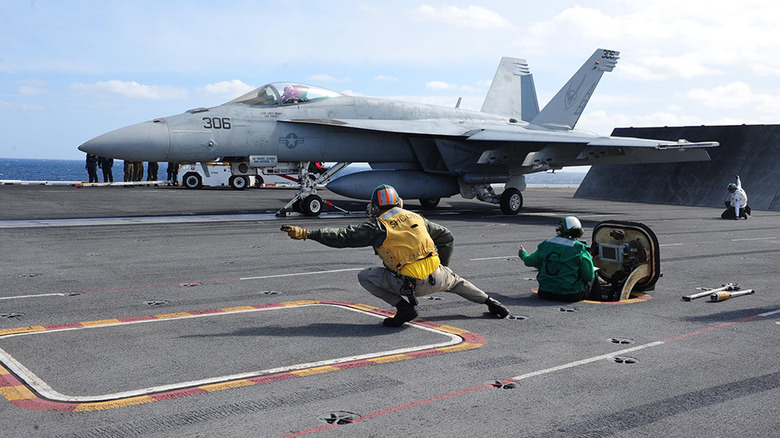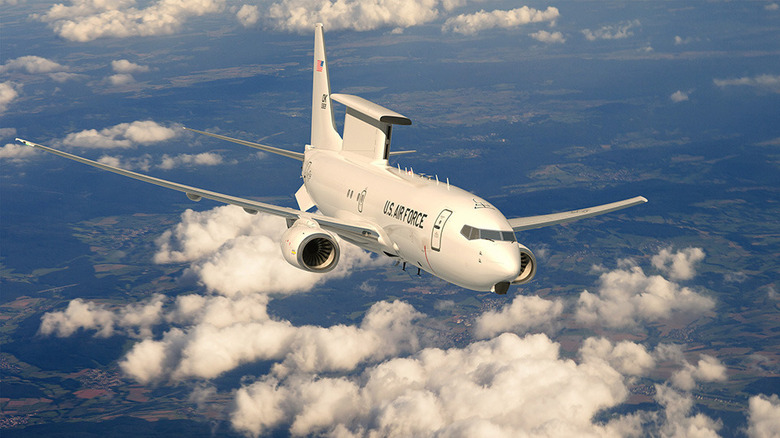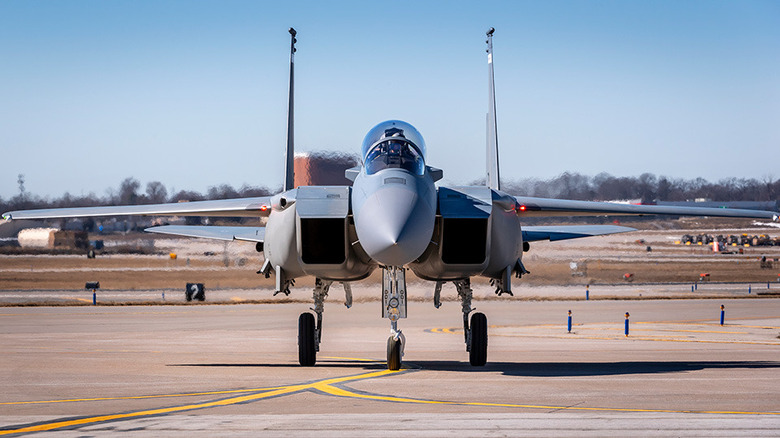5 Boeing Military Planes In Service Today
Boeing is probably among the first names that comes to mind when you think of passenger planes and commercial aviation, and understandably so. This American corporation is behind some of the world's most popular passenger aircraft, including massive people-carriers like the Boeing 747 Jumbo Jet, the Boeing 777, and the modern Boeing 787 Dreamliner jet. The company also makes the Boeing 737 Max jet, one of the most popular — and of late, one of the most safety-issue-plagued — passenger planes in the world. Along with its chief rival, Airbus, Boeing controls nearly all of the world's passenger plane manufacturing business.
But based on overall revenue, Boeing also is among the largest defense contractors on the planet. In fact, the company's Boeing Defense, Space & Security division has a long history of making military aircraft, dating back to 1917, the year the company received its first military contract. Given that the company has over a century of experience designing and manufacturing military planes, Boeing has witnessed both successes and failures.
Today, we take a look at a handful of military planes made by Boeing that are in active service by the U.S. armed forces and their allies across the globe. Given that some military planes from Being are fairly famous and well-known, we are looking at some of the company's lesser-known, but important, military planes.
Boeing C-17 Globemaster III
One of the company's most recognizable military planes, Boeing's C-17 Globemaster III is also one of its largest planes. Known for its immense cargo-carrying capacity, the C-17 Globemaster can carry payloads of up to 164,900 pounds, a number surpassed only by Lockheed's C-5 Galaxy.
What differentiates the C-17 Globemaster from the C-5, however, is its ability to take off and land from virtually anywhere. The C-17, while losing out on sheer carrying capacity, is still massive, and it not only can land and take off from short runways, but can even land on unpaved runways, making it a lot more versatile than the C-5. And despite being smaller than the C-5, the C17 can carry a variety of large cargo types ranging from wheeled U.S. Army vehicles to the M-1 battle tank. When in the air with no load, the plane has a maximum range of 7,169 miles.
The C17 Globemaster III is 174 feet long and boasts a wingspan nearly as long as the plane at 169.8 feet. The massive winged tail rises to a height of 55.1 feet. The power to haul this colossal aircraft is provided by four Pratt & Whitney PW2040 engines that produce 40,440 pounds of thrust each.
McDonnell Douglas originally developed the C-17 Globemaster III; Boeing took over production after the companies merged in 1997. A total of 279 C-17s were produced between 1991 and 2015, with most delivered to the U.S. Air Force.
Boeing KC-46A Pegasus Tanker
Entering service in 2015, Boeing's KC-46A Pegasus Tanker is the U.S. military's newest aerial refueling aircraft. It was conceptualized as a replacement to the aging fleet of Boeing KC-135 Stratotankers, in service since the late 1950s.
The KC-46A Tanker has several advantages over the KC-135, notably the ability to switch among three modes — cargo, passenger and aeromedical evacuation — in just two hours. It also can carry three times more pallets, even matching the massive C-17 Globemaster III in pallet-holding capacity. It can carry twice the passengers of the KC-135, and 30% more patients while undertaking medical evacuation missions.
While designed predominantly as an aerial refueling aircraft, the Boeing KC-46A Tanker also features a long list of defense mechanisms that let it protect itself while serving in hostile territory. These include radio frequency threat detection and an infrared missile system. It also integrates with the U.S. Air Force's Advanced Battle Management System, and can provide other friendly aircraft in the vicinity with crucial battlefield data.
The Boeing KC-46A Pegasus Tanker is a large aircraft measuring over 165 feet long and 156 feet wide, with a maximum takeoff weight of 415,999 pounds. It is powered by twin Pratt & Whitney PW 4062 with engines that produce 62,000 pounds of thrust, and can carry up to 212,299 pounds of fuel. The U.S. Air Force has 87 KC-46A tankers; other countries possessing the aircraft include Japan and Israel.
The Boeing F/A-18 Super Hornet
The F/A-18 was originally designed and manufactured by McDonnell Douglas, and Boeing took up manufacturing the fighter jet following its merger with McDonnell Douglas in the late 1990s. The first F/A-18E/F squadron was formed in 2001, and was deployed on board the USS Abraham Lincoln in July 2022. As a multirole fighter, the plane can perform a wide variety of roles including day and night air strikes, air superiority, fighter escort, maritime strikes, reconnaissance missions and close air support.
Boeing currently makes two variants of the F/A-18 Super Hornet — the Boeing F/A-18E (single-seat configuration) and the F/A-18F (two-seat configuration). The U.S. Navy also uses another variant known as the Boeing EA-18G Growler, a modified version of the Boeing F/A-18 that's high-tech and tailormade for electronic warfare.
All variants of the Boeing F/A-18 Super Hornet get two F414-GE-400 turbofan engines that generate up to 22,000 pounds of thrust per engine. The aircraft can achieve speeds of up to 1.8 Mach, and can operate at altitudes of 50,000 feet or more. Besides the United States, the Boeing F/A-18 Super Hornet is also operated by Australia, Canada, Finland, Kuwait, Malaysia, Spain and Switzerland.
Boeing E-7 Wedgetail
Also known as the Boeing E-7 AEW&C (Airborne Early Warning & Control Aircraft), the Boeing E-7 Wedgetail is a modern-day early-warning and control aircraft. Its primary duty is to ensure the protection of military assets by detecting threats posed by an incoming enemy aircraft, ship or even rockets well in advance. Initially designed for the Australian military, with the first plane entering service in 2013, it has since been used by the Turkish, South Korean and British air forces.
The Boeing E-7 Wedgetail is a rare sight in the United States because it is currently not used by the U.S. armed forces, which rely on the older Boeing E-3 Sentry for warning and control. But the U.S. Air Force has already chosen the Boeing E07 Wedgetail as the E-3's successor.
The Boeing E-7 Wedgetail's fuselage bears an uncanny resemblance to the Boeing 737, if you somehow manage to ignore the large electronically scanned array radar that sits on top of the Wedgetail. This is not by accident — that E-7 Wedgetail is based on the Next Generation Boeing 737-700. Given that the Wedgetail shares a lot of parts with the civilian plane, parts availability is relatively easy, leading to reduced costs.
Notable features of the Boeing E-7 AEW&C include support for air-to-air refueling, and FAA certified communications system. It has a maximum ceiling of 41,000 feet and a range of 4,027 miles.
Boeing F-15EX Eagle II
The F-15EX Eagle II is one of the newest fighter jets made by Boeing, with the first planes being delivered to the U.S. Air Force in March 2021. It's a spiritual successor to the legendary McDonnell Douglas F-15 Eagle, which the Air Force has flown since 1976.
The Boeing F-15EX Eagle II is a multirole strike fighter, conceived because Lockheed Martin's F-22 ended production with only 186 aircraft being delivered instead of the 750 originally envisioned. The shuttering of the F-22 program and delays in the deployment of Lockheed's F-35 meant that the Air Force was staring at a shortfall of available fighters.
The F-15EX Eagle II doesn't have the stealth capabilities of the F22 or the F-35. Where it scores higher is its massive payload capacity of 29,500 pounds, significantly higher than that of the F-35, which is only rated to carry up to 18,000 pounds. Another key advantage of the F-15EX is its ability to shoot from a farther distance than any other fighter aircraft in the Air Force's arsenal.
The first Boeing F-15EX Eagle II aircraft were delivered in 2021. Powering them are twin General Electric F100-PW-229 engines, each capable of generating 29,000 pounds of thrust. The F-15EX has a maximum range of 2,762 miles, supports air refueling, and can cruise comfortably at Mach 2.5.
